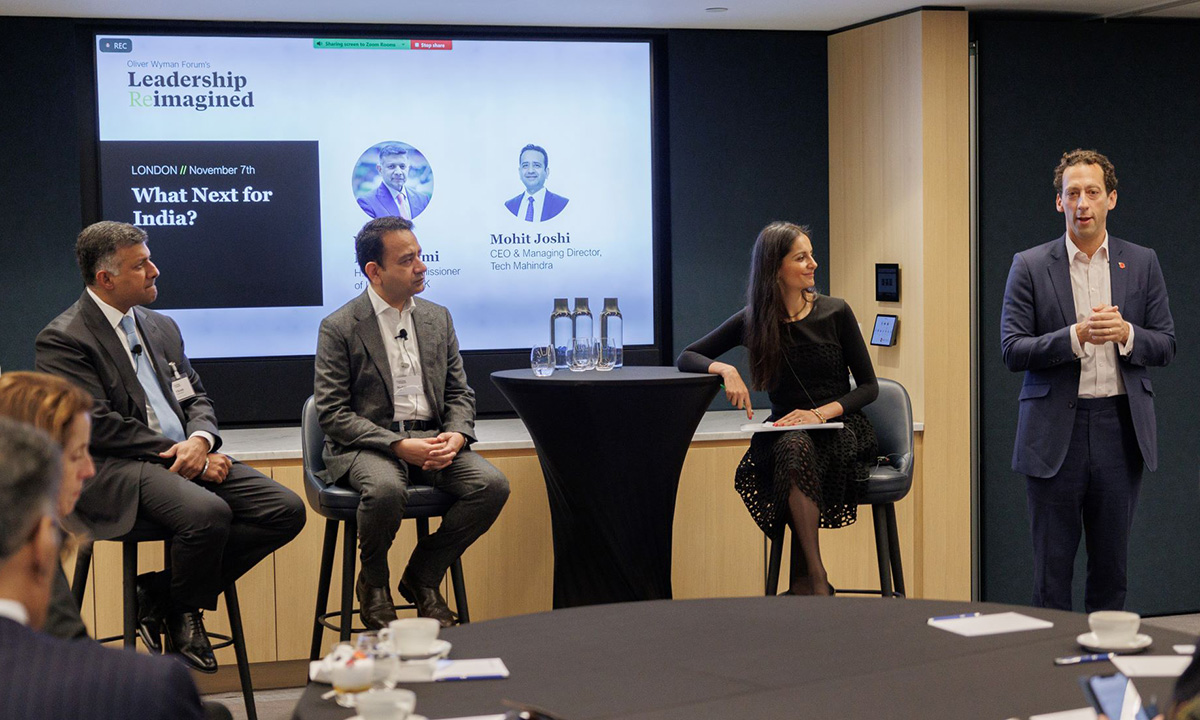With economic growth running at subpar rates in much of the world and geopolitical tensions and threats of protectionism clouding the outlook, India stands out as the strongest performer among major developed and emerging economies. The country has not only overtaken China in population; it is growing at a significantly faster rate while largely avoiding many of the problems troubling its big neighbor.
We convened senior leaders to consider the economic outlook for India. Our two speakers — Vikram Doraiswami, High Commissioner of India to the UK, and Mohit Joshi, CEO and Managing Director of Tech Mahindra — described a confident and ambitious country that has followed its own distinctive development model to great success. Here are a few of our key takeaways:
- India’s more-decentralized and democratic development model is fast becoming an advantage rather than a drawback, especially relative to China. This “precocious democracy,” as Doraiswami put it, hasn’t wavered on its political system since it was founded in turmoil and poverty over 75 years ago. The state played a heavy hand in the economy in the early decades, leading economists to refer to the country’s subpar performance relative to Asian tigers as the Hindu growth rate, but increasing liberalization since the 1990s has paid enormous dividends. The government sets broad objectives rather than detailed five-year plans, leaving room for the private sector to flourish, and it concentrates state investment on core infrastructure like water, sanitation, electricity, and roads. The results: Life expectancy has doubled to more than 70 years, 99% of the population has access to electricity, and over 80% have bank accounts. India’s growth rate will exceed that of China and most other Asian nations for a fourth straight year this year, according to the International Monetary Fund.
- The country’s information technology backbone provides a strong base for continued growth, including in artificial intelligence (AI). Investments in technical schools and universities beginning in the 1960s has enabled the tech sector, including IT services, to become a dynamo that generates 7% of GDP and employs 5.5 million people directly, and as many as 30 million indirectly. This prowess is driving a rapid digitization of the economy and society. The government has provided digital identities to more than a billion people based on fingerprints and retina scans. Digital ID, in turn, provided the basis for a digital payments system that handled 135 billion transactions in the latest year, and for digital lockers that secure documents and enabled people to get COVID vaccine certificates online during the pandemic. AI is the next frontier. Joshi described how Tech Mahindra built a Hindi large language model (LLM) for just $10 million, thanks to India’s low costs. It sees a big market in building local language LLMs for developing countries, starting with Indonesia, and developing use cases such as AI tools for combatting financial fraud and faster customer onboarding. Importantly, most Indian data that can be used for building LLMs is held by consortiums, not big tech companies (as in the United States) or the government (China).
- India’s balanced development strategy leaves it less vulnerable to tariffs and geopolitical tensions. This founding member of the non-aligned movement continues to chart a distinctly non-ideological path. It is a leading player in the BRICS, notwithstanding its long-running border dispute with China; it has increased imports of discounted Russian oil since the start of the Ukraine war, and it continues to cultivate closer ties with the United States. As Doraiswami put it, “We recognize what the world needs is more capacity to cooperate, and less confrontation.” The country is looking to domestic consumption rather than exports to drive growth going forward. The government is investing heavily to expand and upgrade the road network, increase aviation capacity, electrify the railway (it’s already at 80%, second only to Switzerland), and ramp up renewable energy and transmission networks. Many tech companies operating in the United States, meanwhile, are not particularly vulnerable to immigration policy shifts. Some 80% of Tech Mahindra’s 13,000 US-based staff are American citizens or permanent residents. The Indian diaspora — including more than 4 million living in the United States, most for many years — is an underappreciated advantage. Many hold senior positions in business, government, and academia, care about “the mothership,” as Doraiswami put it, and can facilitate closer ties and economic linkages.
- All of these factors amount to a big opportunity for Britain. The UK is only India’s 16th-largest trading partner and efforts to negotiate a free-trade agreement have been delayed by the elections in both countries this year. Doraiswami said the agreement is a key objective of the government of Prime Minister Narendra Modi. The aim is to promote two-way investment flows (India is already the second-largest foreign investor in the UK) and services trade rather than promote manufactured exports or gain more UK visas for Indian workers. UK companies can tap India’s large tech talent pool for legal and financial services support, but services aren’t a one-way street. Tech Mahindra sells roughly a million sport utility vehicles a year and all of them are designed in the UK, home of Mahindra Racing’s Formula E electric car team. India also sees opportunity to deepen cooperation on technology research and development, including in AI. And Modi’s government is looking for closer cooperation in academia that encourages UK institutions to open campuses and programs in India rather than merely increasing the number of Indians (roughly 180,000 currently) studying in the UK.

